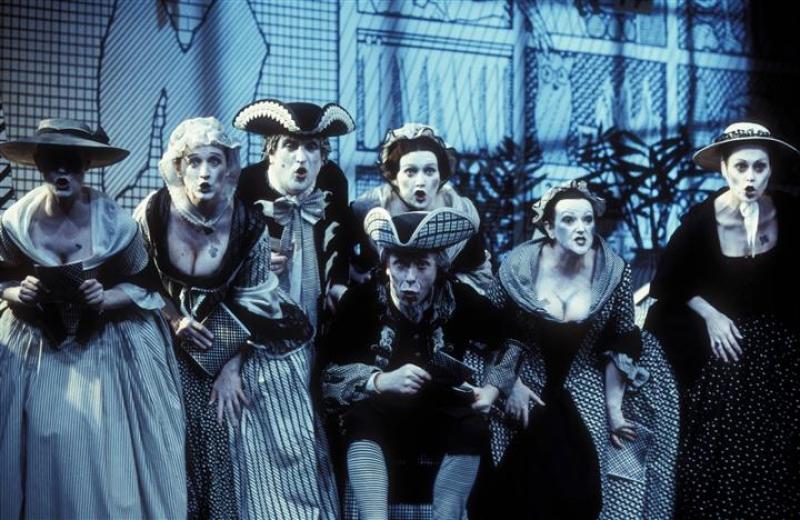


Thirty-five years on and this is still as much David Hockney’s Rake as it is Stravinsky’s or W H Auden’s. How rarely it is that what we see chimes so completely and utterly with what we hear. The limited palette of colours, the precisely etched cross-hatching, the directness and the cunningly conceived elements of parody – am I talking about Hockney or Stravinsky? Two great individualists in complete harmony. So why the disconnection?
I should address this last issue first because things were different in 1975 and the technical practicalities of effecting swift and silent shifts of scene had not really been factored into Hockney’s designs. Nor can modern technology do much about it now, it would seem. His deliciously arresting variations on the Pollock’s Toy Theatre look with its flown cloths and cut-out pieces still relies heavily on other manually moved parts – hence these groaning pauses where the music insists – no, demands – that the narrative speeds attacca from one “etching” to the next. This is the one element where Stravinsky and Hockney are most definitely not in accord. At the very least, the technical team need to work on closing these hiatuses; they are a serious hindrance.
So what of the casting? Well, one tends not to think of accents as too much of a problem in the multi-lingual world of opera but there are some texts – like this one by W H Auden [3] and Chester Kallman – that are so precise, so verbally well tuned, that any distortion in enunciation or inflection blunts the intended effect. So casting a Finn, Topi Lehtipuu (born in Australia and resident in Paris), in the title role is just a little too much impurity for one English gentleman and all the vocal coaching in the world will not eradicate those impure vowels and slightly off-kilter emphases.
That Lehtipuu looks so perfect only adds to the jarring effect of the verbal imperfections. And there is the added problem of a vocal delivery which, though light and pretty in piano, loses focus and support when the voice is pushed. This is a much heavier sing than is often acknowledged and I do wonder if Lehtipuu is simply overparted. He is most effective in the gentle delusions of the final scene where Auden and Stravinsky suddenly and discreetly become heartbreakers and Hockney so brilliantly and chillingly houses the masked inmates of Bedlam in rows of individual pens like so many battery hens. It is perhaps the single most arresting image in John Cox’s production, the other being the scene in which all the trappings of Tom’s redundant life are auctioned off and all hint of colour drains from his world leaving only the auctioneer’s crimson wig as a symbol of what might have been.
It is in that scene, of course, that the deserted Anne Trulove learns that Tom still loves her and it is that love which almost, but not quite, saves Tom from Nick Shadow’s clutches. I shall take from this revival – as I always do from this opera – the sound of the lovely Miah Persson rocking her one true love to sleep to the strains of a lullaby so simple and so deeply affecting that you wonder, as with Mozart, how Stravinsky did it. How can something so intrinsically sentimental simply not be?
Persson’s accent was so well disguised (indeed almost eradicated) as to not prove a problem for me. She looked lovely and sang dreamily, despatching her big bel canto aria “No Word from Tom” with considerable aplomb, even nailing that evil top C which most commentators now suggest was Auden’s fault – a bit of flash to appease the Italians.
The most alarming accent of the evening – Elena Manistina’s Baba the Turk – was the most delicious as if Baba had picked up inflections as well as objects from every exotic clime she visited. And it almost goes without saying – because Nick Shadow is always a scene-stealer – that Matthew Rose was a vocal and physical presence from the moment the Truloves’ garden gate swung open to reveal him, black and cross-hatched as if literally cut out of the shadows.
Vladimir Jurowski predictably relished the 18th century refractions of Stravinsky’s busy score encouraging the tightest rhythms and the most piquant displacements of accent and harmony. The London Philharmonic bassoons got to be stars. And still we went out humming the sets and probably always will.
Links
[1] https://theartsdesk.com/users/edwardseckerson
[2] https://www.addtoany.com/share_save
[3] https://theartsdesk.com/theatre/habit-art-lyttelton-national-theatre
[4] https://theartsdesk.com/opera/glyndebourne-opera-2010-season
[5] https://theartsdesk.com/opera/don-giovanni-glyndebourne-festival-opera
[6] https://theartsdesk.com/opera/h%C3%A4nsel-und-gretel-glyndebourne
[7] http://www.glyndebourne.com/purchase/
[8] https://theartsdesk.com/node/80515/view
[9] https://theartsdesk.com/opera
[10] https://theartsdesk.com/topics/reviews
[11] https://theartsdesk.com/topics/stravinsky
[12] https://theartsdesk.com/topics/lpo
[13] https://theartsdesk.com/topics/london
[14] https://theartsdesk.com/topics/glyndebourne